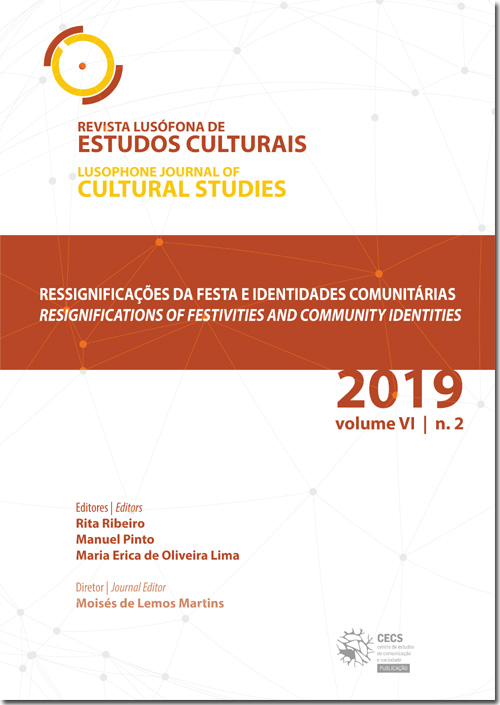Moors versus Christians: from the difference explaining war to the cultural encounter
DOI:
https://doi.org/10.21814/rlec.2367Keywords:
festivities, heritage, Moors and Christians, inversion processesAbstract
São João de Sobrado, also known as Bugiada e Mouriscada, is both a singular object and an event that dialogues with other similar festivities, thus raising different levels of analysis and discission. Although we may find in Portugal other evocative festivals where Christian-Moors fights are staged, the one that is celebrated in Sobrado reveals a very unique character. The absence of a written text to support this representation adds to the complex structure of the festival, with the fusion of several seemingly disconnected moments, ranging from carnivalesque evocations to medieval-inspired farces. On the other hand, when considered in its relationship with other festivals associated with the wars between Moors and Christians, the Bugiada e Mouriscada stimulates the discussion on various topics, defining different axes of analysis. The debate about the relationship between identity and difference is one of these issues, allowing us to discuss, among other aspects, possible processes of reframing the interpretations of the festival, valuing for example the idea of cultural encounter. Also the contemporary processes of cultural heritage conservation should be considered, by which a third axis of analysis is defined, exactly what results from the confrontation of the Bugiada e Mouriscada of Sobrado with other similar festivities, either taking place in Portugal and Spain, or those that migrated to distant places as a result of colonisation, evangelization and other similar processes. Seeking to explore some of these dimensions, this work – as part of an ongoing research – does not have the ambition to be conclusive or even to propose a systemic or integrated approach, but merely to give a contribution.
Downloads
References
Albert, J.-P. (2003). Moros y cristianos en el País Valenciano. La ilusión de la fiesta. In M. Albert-Llorca & J. A. González Alcantud (Eds.), Moros y Cristianos. Representaciones del outro en las fiestas del Mediterráneo ocidental (pp. 89-102). Granada: Preses Universitares du Mirail.
Albert-Llorca, M. & González Alcantud, J. A. (2003) (Eds.). Moros y Cristianos. Representaciones del outro en las fiestas del Mediterráneo ocidental. Granada: Preses Universitares du Mirail.
Anta Félez, J. L. (2003). Valencia, comunidad y complejidad: moros y cristianos en Carchelejo (Jaen). In M. Albert-Llorca & J. A. González Alcantud (Eds.), Moros y Cristianos. Representaciones del outro en las fiestas del Mediterráneo ocidental (pp. 61-74). Granada: Preses Universitares du Mirail,.
Baumann, R. E. (2003). Jugar a “Moros y Cristianos” en válor: ambivalências de las identidades. In M. Albert-Llorca & J. E. González Alcantud (Eds.), Moros y Cristianos. Representaciones del outro en las fiestas del Mediterráneo ocidental (pp.75-87). Granada: Preses Universitares du Mirail.
Caro Baroja, J. (1984). El Estío Festivo. Fiestas populares del verano. Madrid: Taurus Ediciones.
Fernández Juárez, G. & Martín Gil, F. (2002). La fiesta del Corpus Christi. Cuenca: Ediciones de la Universidad de Castilla-la-Mancha.
González Alcantud, J. A. (2003). Para sobrevivir a los estereótipos culturales: estruturas e paródicas de las fiestas de moros y cristianos. In M. Albert-Llorca & J. A. González Alcantud (Eds.), Moros y Cristianos. Representaciones del outro en las fiestas del Mediterráneo ocidental (pp. 45-59). Granada: Preses Universitares du Mirail.
Heuzé, L. (2003). La incorporación de las mujeres en las fiestas de Petrer (Alacant)”. In M. Albert-Llorca & J. A. González Alcantud (Eds.), Moros y Cristianos. Representaciones del outro en las fiestas del Mediterráneo ocidental (pp. 103-114). Granada: Preses Universitares du Mirail.
Iáñez, E. (2002/1989). História da Literatura Universal, vol II, A Idade Média. Lisboa: Círculo de Leitores.
Macedo, J. R. (2008). Mouros e cristãos: a ritualização da conquista no velho e no Novo Mundo. BUCEMA, Bulletin du centre d’études médiévales d’Auxerre, 2.
Nery, R. V. (2004). Para uma História do Fado. Lisboa: Público.
Oliveira, E. V. de (1995/1984). Festividades Cíclicas em Portugal. Lisboa: Publicações Dom Quixote.
Pinto, M. (1983). Bugios e Mourisqueiros. Valongo: Associação para a Defesa do Património Natural e Cultural do Conselho de Valongo (ADEPAVAL).
Pinto, M. (2000, abril). A Bugiada: festa, luta e comunicação. Comunicação apresentada ao IV LUSOCOM – Encontro Lusófono de Ciências da Comunicação, São Paulo.
Puccio, D. (2003). La morisma, fiesta de conversión. In M. Albert-Llorca & J. A. González Alcantud (Eds.), Moros y Cristianos. Representaciones del outro en las fiestas del Mediterráneo ocidental (pp. 135-150). Granada: Preses Universitares du Mirail.
Scott, J. C. (1992). Domination and the Arts of Resistence. New Haven: Yale University Press.
Downloads
Published
How to Cite
Issue
Section
License
Authors own the copyright, providing the journal with the right of first publication. The work is licensed under a Creative Commons - Atribuição 4.0 Internacional License.












